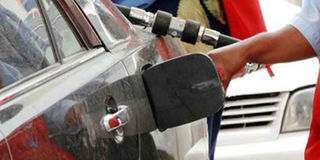What is the plan for fuel-powered cars and filling stations?

With many companies indicating that they will phase out Internal Combustion Engine cars, fuel stations need to think of a measure that will allow them to fit into the electric vehicle driven market. FILE PHOTO
Talk about electric vehicles (EVs) has taken the car industry by storm and as it seems there will be no way around it.
Some manufacturers have even set their production dates. By 2025 some countries will already have started mass production of EVs with the likes of Volvo putting production at 2019. Toyota and Volkswagen hope to get on board by 2020.
Allan Muhumuza, the Kiira Motors Corporation vice president in charge of marketing and sales, has a comprehensive understanding of this subject having been at the centre of Uganda’s first prospecting company to venture into the manufacture of solar powered and electric cars.
According to Muhumuza, starting KMC was strategic on the part of Uganda because “internal combustion engines have a just some little time to find their way of the world market.
“We are already seeing the future unfold with various vehicle manufacturers already setting ambitious targets for production of electric vehicles. The production of our concept vehicles was out of the need for sustainable mobility solutions for Africa addressing issues of air quality and pollution,” he says.
However, he is cautious of the fact that Uganda has got more work to do to have the right technology
The work, he adds, must cover different stakeholders including fuel stations that will provide sustainable energy solutions by setting up charging units that must at least be ready by 2025.
The plans, if realised will be a game changer for the oil industry that Uganda hopes to join in 2020 after launching into the production phase.
Uganda plans to have started drilling oil by 2020, the time when some automakers have already indicated as their production year of electric vehicles.
However, Muhumuza believes that oil will still be an important facet of the industry because the bi-products such as lubricants and plastics will still be vital.
The Kayoola Solar Bus runs on two battery banks limited to an 80 kilometres range on a single charge.
However, KMC plans to explore other innovations such as plug-in hybrid electric vehicles, range-extended electric vehicles, fuel cell electric vehicles and (conventional) hybrid electric vehicles.
“We continue to explore sustainable mobility solutions for Africa that foster environmental stewardship. We will embrace and incorporate technologies as they advance and mature,” he says.
Just like refilling a car, an electric vehicle will need to be charged to obtain power and therefore fuel stations could start planning now to make a turnaround when the inevitable finally arrives.
“The trend now is pointing towards an electric future for mobility. African countries such as Morocco and South Africa are already adapting electric vehicles. Uganda is expected to have electric cars on its roads by 2030 and charging infrastructure by then just like we see fuel stations today. Technology will have greatly advanced and related costs might have come down by the,” he says.
With the emergence of electric vehicles and many countries pushing for zero emissions the business of and there is need for a holistic multi-sectoral planning if they are to survive.
Disruption for fuel stations
According to Muhumuza, electric mobility will greatly disrupting the fuel market globally.
However, he argues that Internal Combustion Engine cars will not disappear overnight, especially in Africa where people are still driving vehicles that were manufactured 30 years ago.
Some countries such as Germany, France, UK, China, Norway and Indi have set targets with UK particularly indicating it would have abolished Internal Combustion Engines by 2040.
Such plans are quite ambitious and there are indications that they are likely to keep Internal Combustion Engines for some time.
This, Muhumuza says, means that Internal Combustion Engines will co-exist alongside electric vehicles as they are symmetrically phased out.
“I wouldn’t be surprised when some existing fuel vehicles are converted to electric vehicles as technology continues to advance,” he says.




